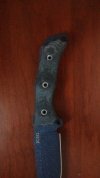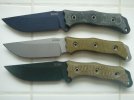- Joined
- Sep 16, 2012
- Messages
- 331
I used the search function and found info on g-10 which might be the same. Can you leave the slabs on? Done by hand, or can you use a dremel with sanding drum?
The BladeForums.com 2024 Traditional Knife is ready to order! See this thread for details:
https://www.bladeforums.com/threads/bladeforums-2024-traditional-knife.2003187/
Price is $300 $250 ea (shipped within CONUS). If you live outside the US, I will contact you after your order for extra shipping charges.
Order here: https://www.bladeforums.com/help/2024-traditional/ - Order as many as you like, we have plenty.
Thank you sir! That is all I needed to move forward. I will start with 400 grit and go from there.Yes and yes. The method used should be determined by the amount of material you desire to remove and how smooth the final result is intended to be. Slow and easy trial and error is your best teacher here.



I recently did one of my TG's. Just tape off the ceracote and have at it. I used 60 grit.
Came out great.



20180125_125323.jpg
Snakebreaker
LINK
DIRECT
FORUM
ALT
HTML
The dowels are a great idea, thinking of going the hand route so as to minimize mistakes first time.Wooden dowels help for accurate removal of material. Using these you can apply pressure right where you want, and the diameter that you want to carve.
For rounding corners, smoothing seams, and angles, a soft backing works well. Think along the lines of dense leather, or compressed cardboard of varying amounts of layers (this will adjust the cushion effect).
Most local machine shops, paint shops, and other mechanical manufacturing businesses should be able to point you in the direction of a media blast cabinet. This will abrade the resin, while not damaging the fibers all that much, leaving them more proud, and leaving a cleaner end result when left at a low grit (400-600 grit) finish.
That being said, I personally have brought black canvas micarta up to 5k grit for a traditional folder that I made scales for.
Most canvas micarta will have better grip when wet, and this goes for low or high polished slabs alike.
I gave my dad a Work Sharp for Christmas two years ago that he has never used, maybe I can reallocate it for this purpose!I've done a couple and for me, a combination of 2 things.
First, I have the Onion Work Sharp - That little feller is an awesome little belt sander and really flexible belts that follow the contours fantastic combined with the variable speeds is a great tool. I did my first one with it and came out great.
The other, I recently added a rotating vice to my bench and a box of various grits of 1" wide "turners mesh" for shaping by hand. Clamp the blade so it's horizontal and make dust!
For me, the Work Sharp was the sht! Easy to control the removal just doing a smoothing job and with the various grit belts I don't think it took an hour the first time being cautious not wanting to screw it up and a bit nervous to be honest LOL!
On the other hand, you can't argue with Snakebreakers results! That's beautiful.
Careful, micarta can burn, sort of. This would be mitigated by having a variable speedand lighter pressure.That is what I am going for, stunning!
The dowels are a great idea, thinking of going the hand route so as to minimize mistakes first time.
I gave my dad a Work Sharp for Christmas two years ago that he has never used, maybe I can reallocate it for this purpose!
It was difficult in between the rivets in the valley of the handle. I will not contradict the advice to do it by hand, but after an hour I switched to the Dremel on low speed and found it much easier to evenly sand. After spraying with WD-40, them a couple coats of mineral oil I'm pretty happy with the results. Camera sucks, but it looks pretty good in person.Nice work.
What did you find to be the easier parts?
Did any spots cause any concern or give you any hiccups?


